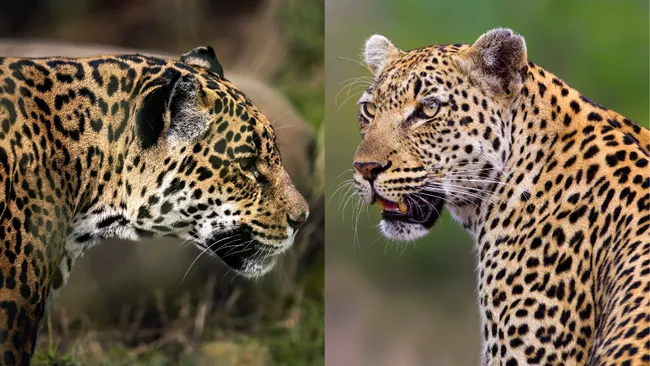Look closely at the spots to tell leopards from jaguars: there’s a subtle clue.
Leopard or Jaguar? How to Tell These Big Cats Apart
A large predator moves through the underbrush, its muscular body covered in tan fur patterned with black rosettes. Is it a leopard—or a jaguar? With their stealthy hunting styles and similar coats, these two big cats are notoriously easy to confuse. So, what sets them apart?
Where They Live
One of the biggest differences between leopards and jaguars is where they live. Jaguars are native to the Americas, found today in regions from Mexico down to South America. Leopards, on the other hand, live across Africa, the Middle East, and parts of Asia.
Despite living on opposite sides of the world, they share a distant common ancestor. According to Allison Devlin, jaguar program director at Panthera (a global wild cat conservation group), jaguars, leopards, and lions all share a more recent ancestor, separate from tigers and snow leopards within the Panthera genus.
Jaguars diverged from the leopard-lion line between 3.6 and 2.5 million years ago and migrated from Eurasia into the Americas via the Bering Land Bridge. They are now the only member of the Panthera genus found in the Western Hemisphere.
Leopards split from lions about 2 million years ago and evolved into eight distinct subspecies across their vast range. While jaguars remain a single species, leopards show more regional variation.
Spotting the Difference: Rosettes and Color
At first glance, both cats have golden coats with dark spots, but their markings differ in key ways:
- Jaguar rosettes are large and often have a central spot inside each ring.
- Leopard rosettes are smaller, densely packed, and lack those interior dots.
Tara Pirie, a lecturer in ecology and conservation at the University of Surrey, adds that jaguar rosettes are more spaced out, while leopard spots are more compact.
These spot patterns aren’t just for show—they’re camouflage. Both cats hunt by ambush in forested or semi-shaded environments, and their coats help them blend into dappled light. This is a classic example of convergent evolution, where unrelated species evolve similar traits in response to similar environments.
Built for the Hunt
Leopards and jaguars also differ in body type and hunting style.
- Leopards are agile all-rounders, built for speed, stealth, and climbing. Weighing up to 176 pounds (80 kg), they typically kill prey by biting the throat, then drag their meal into trees to keep it safe from scavengers. Their long tails (up to 1 meter) help with balance in the treetops.
- Jaguars, by contrast, are stocky powerhouses. Weighing up to 260 pounds (120 kg), they have massive chests and skulls designed for strength. Their bite is so powerful they can crush turtle shells or bite through skulls, killing prey in a single blow. Though they can climb, they spend less time in trees compared to leopards.
The Mystery of the Black Cats
Both species also have rare melanistic (black) variants—not different species, but genetic color phases. These all-black leopards and jaguars still have visible rosettes under the dark coat.
Interestingly, melanism is more common in densely forested habitats, where dark coats offer better camouflage. In jaguars, black individuals are mostly found in the Amazon rainforest. Among leopards, melanistic individuals are more frequent in the jungles of Southeast Asia, like Malaysia.
Shared Threats, Shared Hope
Despite their strength and adaptability, both leopards and jaguars face population decline due to habitat loss, poaching, and the illegal wildlife trade. The International Union for Conservation of Nature (IUCN) lists both species as threatened.
But their future isn’t sealed. “If they have the habitat, the prey, and the protection they need, they can persist,” Devlin emphasizes.
